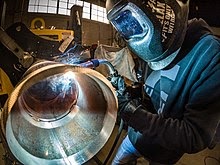Get to Know: Welding Classification
📆 2021-02-22

Welding is a process, a method, of making iron joints by burning. The Combustion in welding involves very high temperatures and must be high enough to reach the melting point of the metal to be joined.
These high temperatures come from a variety of sources depending on the welding process and are used to melt the metal being joined. The metal that enters the liquid phase mixes and then solidifies and becomes a weld joint. Therefore, the use of the term “through the liquid phase” provides a more descriptive picture of welding.
In an infrastructure development, material joining technology is a vital requirement. When we discuss an infrastructure with a metal base material (steel, aluminum), welding is the most widely used connection method.
The welding procedure seems very simple, but in fact there are many things or problems that have to be overcome, which requires a variety of knowledge. Therefore, in welding, knowledge must accompany practice. For example, the design of building construction and machines with welded joints, should also be planned about the methods of welding.
Classification Oof Welding Methods
Until now, a lot of classifications are used in the welding field, this is because there is a need for agreement in these matters. Conventionally, the classification methods are divided into two groups, namely classification based on work and classification based on energy used.
The first classification divides welds into liquid welding, pressure welding, solder welding and others. While the second classification distinguishes the existence of groups such as electric welding, chemical welding, mechanical welding and so on. If there is a more detailed classification, the two classifications mentioned above will form a lot of groups.

Between the two methods of classification, the classification of work methods is more widely used, therefore the classification that is explained is based on the method of work. Based on this, welding can be divided into three main classes namely: liquid welding, press welding and desoldering. Let's see what the description of the classification about the welding is.
Liquid welding is a method of welding in which the joint is heated until it melts with a heat source from an electric arc or a source of burning gas.
Press welding is a method of welding where the joints are heated and then pressed together./p>
Desoldering is a method of welding where the joints are bonded and held together using a metal alloy that has a low melting point. In this case the parent metal does not melt too.

Welding using electric arc welding is divided into 2 categories, which Consumable Electrodes and Non Consumable Electrodes. The classification of the process is based on the use of the type of electrode whether it burns and melts with the weld metal during the welding process or not.
What is meant by Consumable Electrode is that the electrode is burned out as well as a filler in the weld metal. Various types of welding in the Consumable Electrode category include Shielded Metal Arc Welding (SMAW), Gas Metal Arc Welding (GMAW / MIG), Submerged Arc Welding (SAW) and Flux Core Arc Welding (FCAW).
Meanwhile, non Consumable Electrode is a welding process in which the electrode does not burn. The filler uses other ingredients that are melted together with the melting process of the parent metal. The most popular types of welding Non Consumable Electrodes are Gas Tungsten Arc Welding (GTAW / TIG).
Good classification and welding methods can be found in a trusted welding service company in Indonesia, namely PT. Duta Laserindo Metal, a trusted and professional guarantee in welding services.
別の記事

An Importance of 3D Design in Manufacturing
In the previous article, we discussed the importance of 2D Sketch / Design. Now, let's discuss why 3D design is important in a manufacturing company like PT DLM?...
略さずに →
5 Types of PPE for Process Welding Safety
The welding process is one of the jobs that has many high risks. It is because, during the welding process, smoke, welding light, heat, and electrical hazards will arise. Therefore, it is very dangerous if you do not use welding safety tools according to the SOP....
略さずに →

